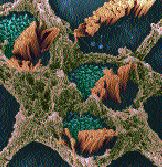If we are going to live so intimately with these chemicals--eating and drinking them, taking them into the very marrow of our bones--we had better know something about their nature and their power.
Rachel Carson, Silent Spring, 1962
One of the mostly hotly debated questions in nutrition today is whether--and how well--so-called functional foods are being regulated. Conventional foods become marketable as functional foods when they are supplemented with ingredients that confer health benefits beyond basic nutrition--souped-up soup, one might say. On 25 March 1999, the Center for Science in the Public Interest (CSPI), a nonprofit health advocacy group in Washington, DC, released a report titled Functional Foods: Public Health Boon or 21st Century Quackery? The report describes the functional foods markets in the United States, Japan, and the United Kingdom, and issues a strong call to the U.S. Food and Drug Administration (FDA) to more tightly regulate the labeling and marketing of these products.
Functional foods hold tremendous promise for benefiting public health. Problems arise, says the report, when functional foods claim that a particular ingredient confers some health benefit when there may be no conclusive evidence supporting the claim. Some functional food products may contain insignificant amounts of the promoted ingredient as well as unhealthful ingredients, such as fat and sugar, that override any health benefit provided by the functional ingredient.
A key problem, contends the report, is that the distinction between foods and drugs is becoming increasingly blurred as the number of functional foods on the market continues to grow. Some functional foods are being marketed as dietary supplements, says Ilene Ringel Heller, a senior staff attorney for the CSPI and a coauthor of the report, when they should be regulated as foods with unapproved additives or as drugs. Dietary supplements are defined under the 1994 Dietary Supplement Health and Education Act (DSHEA, pronounced "de SHAY") as edible substances with ingredients such as vitamins, minerals, herbs, and amino acids that are taken to augment the nutrients derived from conventional foods. Prior to 1994, the FDA could regulate dietary supplements as food additives, which must have FDA approval prior to marketing unless they are considered to be generally recognized as safe. DSHEA prohibited the FDA from treating dietary supplements as food additives; although the FDA still requires a 75-day notification period prior to the marketing of a new dietary supplement (during which time the agency may challenge any labeling claims made by the manufacturer), FDA approval is not actually required for a dietary supplement to be put on the market.

Food for thought. Grocery manufacturers, the FDA, and public interest groups are embroiled in a debate over the labeling of functional foods.
DSHEA also allows the use of structure/function claims on supplement labels. These statements can be difficult to distinguish from health claims--claims that a product will prevent, cure, or treat a disease--which must be specifically approved by the FDA. For example, the structure/function claim "Calcium is necessary for bone growth and development" becomes a health claim if the word "osteoporosis" is introduced into the statement.
The CSPI report claims that some manufacturers seek to avoid costly and time-consuming FDA approval entanglements by taking advantage of what it classifies as DSHEA's less stringent provisions; indeed, says Heller, some manufacturers are marketing functional foods as dietary supplements and making structure/function claims that are essentially implied health claims. For instance, says the report, the labels on Hain Kitchen Prescription canned soups, which contain medicinal herbs such as echinacea, indicate the products are supplements and feature structure/function claims normally found on dietary supplement labels. But Stacey Zawel, vice president of scientific and regulatory policy at Grocery Manufacturers of America, an industry organization based in Washington, DC, says this is an inaccurate leap on the report's part. She says, "Provisions for functional foods and dietary supplements are simply different--not necessarily less or more stringent. If you really dissect the laws, you will find that it's a wash as to which is more difficult. . . . The law already requires all products to present labeling information that is truthful and not misleading. There is no difference for any claim you make on your food, structure/function or otherwise." Furthermore, Zawel says, there is absolutely no evidence of an onslaught of inappropriate structure/function claims. She says, "Every example that is provided in [the CSPI report] is perfectly legal under FDA law." Heller calls this stance "disingenuous," saying, "The examples . . . speak for themselves."
The report makes several recommendations for FDA action. First, the FDA should prohibit companies from marketing functional foods as dietary supplements, and make it clear that health claims for functional foods are subject to the same preapproval requirements that apply to all other foods. Functional ingredients added to foods should be regulated as food additives unless they are generally recognized as safe, and the FDA should also impose tighter regulation of structure/function claims for foods and require that they be based on universally recognized scientific facts, such as the fact that calcium is necessary for bone growth and development. The report also recommends that the FDA establish a postmarket surveillance system that would monitor adverse health effects from functional ingredients in foods. Finally, the report recommends that the FDA require foods making structure/function claims to meet certain nutritional guidelines: they must not contain unhealthful levels of fat, saturated fat, cholesterol, or sodium, and they should, prior to fortification, contain at least 10% of the recommended daily intake of certain desirable nutrients such as vitamin C.
For now, the two sides of the functional foods debate remain at loggerheads. Zawel says, "[Functional foods] are governed by all laws covering conventional foods. It is that simple. The FDA has conveyed to us that, in fact, no new regulations are needed to regulate these products." Heller maintains, however, that "the FDA has to begin addressing the regulation of functional foods. 'Functional foods' is a concept that everyone knows about but for which there is no official policy. The FDA must face the issues raised by these products to ensure that functional foods become a public health boon rather than the snake oil of the 21st century."
Patricia Eagon, an associate professor of medicine at Pennsylvania's University of Pittsburgh, decided to consult an herbalist after she began to suspect that Premarin, the prescription estrogen she was taking for menopausal symptoms, was causing a rash on her leg. The herbalist, whom she had consulted before on other health matters, gave her a mixture of several herbs to take instead of Premarin. The concoction both relieved Eagon's hot flashes and piqued her curiosity about how the herbal ingredients worked.
Eagon decided to launch her own experiment to find out. She conducted an estrogen-binding assay on 15 herbs commonly used in treating menopause, including 3 from the remedy she had taken herself. Herbs that showed estrogenic activity in the screening were then fed to rats that had undergone ovariectomy. To test the herbs' estrogenicity, Eagon weighed the rats' uteri at the end of the study and measured changes in the concentration of luteinizing hormone in their blood (enlarged uterus and decreased luteinizing hormone concentration are both indicators of estrogenic activity). The tests indicated an estrogenic effect in four of the herbs--chaste tree berry (Vitex agnus-castus), dong quai (Angelica sinensis), American ginseng (Panax quinquefolium), and black cohosh (Cimicifuga racemosa). Eagon reported her findings on 11 April 1999 at the annual meeting of the American Association for Cancer Research and is currently preparing the results for publication.

|
Herbal estrogens. A recent study by associate professor of medicine Patricia Eagon suggests that some herbs may have powerful estrogenic properties.
Photo credit: Laura J. Stafford |
Eagon's findings have implications for the fast-growing number of people who are embracing alternative medicine. According to the U.S. Food and Drug Administration (FDA), more than half of all U.S. adults use over-the-counter vitamins, dietary supplements, or herbal remedies. Ann Fonfa, founder of the New York City-based Annie Appleseed Project to promote the study of alternative cancer treatments, estimates (based on national averages for the general population) that 30% of menopausal women treat themselves with medicinal herbs, many because they believe such herbs are safer and gentler than prescription drugs. Yet they have no proof of the herbs' medicinal value and safety beyond the folk wisdom of herbalists; unlike pharmaceutical manufacturers, manufacturers of herbal remedies are not required by the FDA to prove their products' safety and efficacy.
Eagon's discovery of estrogenicity in the herbs she tested comes as no surprise to some researchers. "While the specific findings are new, there is well-known, well-described estrogenic activity in plants," says Daniel Sheehan, director of the Endocrine Disruptor Knowledge Base Program of the FDA's National Center for Toxicology Research in Jefferson, Arkansas. He points to the example of subterranean clover, a type of clover that farmers have known for 50 years to cause reproductive failure in sheep.
While Eagon's research may help explain why certain herbs may relieve hot flashes and other menopausal symptoms, it raises several more questions. Of key interest is how these phytoestrogens react in the body. "We really need to measure these things in women," Eagon says.
Premarin has long been doctors' drug of choice in treating menopause because it not only relieves symptoms but also helps prevent osteoporosis and heart disease. However, the synthetic hormone also elevates women's risk of breast and uterine cancer, which scares many would-be users away.
Because of the estrogenic activity she observed in the herbs she studied, Eagon feels compelled to warn women at high risk of breast or uterine cancer against taking them, as estrogen has been implicated in some forms of cancer. Yet she admits she doesn't know if the herbs promote cancer. In fact, she says, "We may test these further and find they inhibit cancer. It looks as if soy has a positive effect in preventing breast cancer. These herbs may also be able to prevent it."
Eagon also doesn't know if estrogenic herbs give women the same protection against heart disease and osteoporosis that synthetic estrogen does. "One question is, how do estrogenic substances from plants compare in activity with pharmaceutical estrogens," says Fredi Kronenberg, director of the Rosenthal Center for Complementary and Alternative Medicine at Columbia University College of Physicians and Surgeons in New York City. "Do they have a broad spectrum of estrogenic activity or are they more selective in action? We don't have the answer yet."
Some of those answers may come out of Eagon's upcoming research. She first plans to investigate whether the herbs inhibit or promote breast cancer by feeding them to rats with a genetic susceptibility to the disease. Eagon also plans to delve into the herbs' effects on premenopausal women. Younger women take chaste tree berry and dong quai for premenstrual syndrome, amenorrhea, and infertility; American ginseng is recommended for stomach upset, lack of appetite, physical exhaustion, and infection. Eagon would use mice with intact ovaries to simulate the impact on premenopausal women.
"People think [taking herbal remedies] is like eating another serving of broccoli," Eagon says. "These things are not all benign. The more we know about them, the better off we'll be."
When monoclonal antibodies were first developed 20 years ago, they were hyped as a magic bullet for curing cancer and other diseases. However, killing cancer cells with these immune proteins, which are artificially produced and which neutralize one specific antigen or foreign protein, was not as straightforward as first assumed, and clinical failures occurred. Moreover, the high cost of producing monoclonal antibodies by traditional cell fermentation methods limited their applications. These setbacks have forced scientists to look more realistically at monoclonal antibodies.
Now, researchers at EPIcyte Pharmaceutical, based in San Diego, California, hope to revitalize interest in monoclonal antibodies with a new technology that produces large supplies of the proteins inexpensively. Their new technology uses green plants to churn out large quantities of "plantibodies." After undergoing some genetic engineering, plant cells easily assemble monoclonal antibodies. Plants are expected to be able to make unlimited quantities of plantibodies at prices that will be 25-100 times less expensive than cell fermentation methods.
The current standard cell fermentation methods can produce just 5-10 kg of a monoclonal antibody in a year. In comparison, EPIcyte plans to produce 10,000 kg of key plantibodies per year. The current high cost of monoclonal antibodies, which ranges from $200 to $1,000 per gram, is predicted to fall to $10-100 per gram or less as plants produce tons of plantibodies.
A large, cheap supply means that new medical, consumer, and industrial applications for monoclonal antibodies could become economically feasible. For instance, plantibodies could target toxicants or pollutants in large-scale water purification systems, theorizes biochemist Andrew Hiatt, a developer of plantibodies who cofounded EPIcyte in 1996 along with plant physiologist Mich Hein. Plantibodies that sequester heavy metals or radioactive compounds could become tools for bioremediation.
The first plantibodies were produced in tobacco plants, but to meet commercial demands, EPIcyte is developing corn that produces monoclonal antibodies. Corn is the most widely grown crop worldwide, and its seed (kernel) naturally stores plantibodies in a low-moisture environment that is loaded with protective protease inhibitors. Stored plantibodies can be purified as needed by standard milling procedures. The high-molecular-weight (300,000-400,000 daltons) plantibodies easily separate from the low-molecular-weight (< 50,000 daltons) corn proteins when solubilized.
The first clinical evidence of plantibodies' effectiveness appeared at Guy's Hospital in London. A plantibody against Streptococcus mutans, which produces lactic acid and erodes tooth enamel, was produced in tobacco plants. When brushed onto human teeth for three weeks, the plantibody prevented tooth decay for up to four months, as described in the May 1998 issue of Nature Medicine. The plantibody "specifically inhibits Streptococcus from binding to tooth surfaces," says Hiatt.
EPIcyte holds exclusive license for plantibody technology from The Scripps Research Institute in La Jolla, California. In alliance with ReProtect of Baltimore, Maryland, EPIcyte is developing preclinical topical gels that contain plantibodies for herpesvirus types 1 and 2. In a study published in the December 1998 issue of Nature Biotechnology, scientists at ReProtect applied an experimental plantibody to the vaginas of mice, which prevented infection with genital herpes. EPIcyte and ReProtect scientists are planning a joint project to make a more potent herpes plantibody to protect newborn babies against transmission of herpes from infected mothers during delivery.
"The greatest potential for monoclonal antibodies lies in prevention," says Kevin Whaley, a reproductive biologist at The Johns Hopkins University in Baltimore who also works for ReProtect. From a public health perspective, plantibodies are ideally suited for preventing sexually transmitted diseases as over-the-counter products. More than 5 million people in the United States are infected with sexually transmitted diseases annually at an estimated cost of $12 billion in medical treatment. Whaley says, "[Monoclonal] antibodies are so potent and so specific, they can be used in novel ways," such as personal lubricants, gels, or controlled-release devices for vaginal insertion. To accommodate personal preferences, several different user-friendly formulations for plantibodies will be developed, says Whaley.
Two separate teams recently published findings that may help prevent or reduce noise-induced hearing loss, the most common form of hearing loss. According to the American Academy of Otolaryngology, an estimated 16-24 million people in the United States have some amount of hearing loss due to sensory hair cell loss. Hair-cell loss can be caused by overexposure to loud noise, ototoxic drugs (including some antibiotics and anticancer drugs), disease, genetic factors, and simple aging. Experts generally agree that continuous noise levels over 80 decibels, or about the loudness of a busy city street, can be hazardous to hearing.

|
Bird's-ear view. Studying normal and regenerating hair cells in birds may help researchers find answers to hearing loss in humans.
Edwin W. Rubel, Dale Cunningham
|
The cochlea, a bony, coiled, fluid-filled structure of the inner ear, is lined with an epithelial layer called the organ of Corti. This organ is lined with microscopic hair cells that translate sound waves into nerve impulses that are sent to the brain. Loud noises can overstimulate and subsequently kill these hair cells. Once the hair cells are damaged, the ear can no longer transmit sound to the brain. Although birds can regenerate damaged hair cells, humans cannot; lost hair cells mean permanent hearing loss.
Richard J. Salvi, a professor of communicative disorders and sciences at the University of Buffalo in New York, and colleagues Alfred Stracher and Abraham Shulman, both of the State University of New York Health Science Center in Brooklyn, have discovered that a compound called leupeptin may protect against noise-induced hearing loss by preventing the loss of hair cells. The study was published in the 17 March 1999 issue of NeuroReport.
The scientists infused the right cochleae of several chinchillas with leupeptin for 14 days, while the left cochleae were left untreated as a control. The chinchillas were exposed to noise at either 100 or 105 decibels for 48 hours. The scientists found that the untreated cochleae lost massive amounts of hair, ranging from nearly 100% in the basal portion to about 15% in the uppermost portions. Conversely, the treated cochleae retained all but a few hairs. Overall, leupeptin reduced the loss of outer hair cells--the cells that are first damaged by noise--by an average of 60%.
The study was based on the premise that exposure to loud noises causes an increased production of calcium in nerve cells. This starts a chain of events that eventually leads to nerve degeneration. Leupeptin is one of a family of peptides that have been shown to short-circuit this chain of events. It is not clear, however, exactly how leupeptin works to protect the hair cells.
In a companion study, the scientists found that leupeptin didn't protect against the ototoxic effects of the anticancer drug carboplatin, possibly due to the mechanism by which carboplatin causes hearing damage. But Salvi is not discouraged; on the contrary, he believes leupeptin or a similar compound may yet be useful against the effects of ototoxic drugs. "We hope compounds like this will have some therapeutic value, perhaps provide protection against carboplatin or cisplatin [another anticancer drug]" he says, adding that such compounds could be used in tandem with ototoxic drugs.
Meanwhile, a team of scientists from Tübingen, Germany, Seattle, Washington, and Keele, United Kingdom, are looking at why mammals alone among vertebrate animals are unable to regenerate damaged sensory hair cells. In a study published in the 30 March 1999 issue of Proceedings of the National Academy of Sciences, the team "demonstrates for the first time a molecular mechanism explaining why mammals turn off cell division in the sensory hearing organ," says Hubert Löwenheim, a professor in the Hearing Research Center at the University of Tübingen.
Earlier studies by collaborator Edwin Rubel, a professor of otolaryngology at the Virginia Merrill Bloedel Hearing Research Center of the University of Washington, and colleagues showed that hair cell regeneration in birds actually occurs as a two-fold process. First, so-called support cells, which surround the actual hair cells, must reinitiate the process of cell division, which in most animals normally occurs only during embryogenesis. In the second part of the process, these newly produced cells can then become either new support cells or new hair cells. In mammals, the ability of support cells to proliferate shuts down once the original sensory hair cells are established during fetal development. Rubel says scientists aren't sure why mammals are unable to replace damaged sensory hair cells. "Mammals hear at a much higher frequency than any other vertebrate. Limiting cell division may be a protective mechanism to keep the hearing system tuned to high frequencies," he says.
The team found that the kinase inhibitor p27Kip1 is expressed in the supporting cells of the mammalian organ of Corti. In other types of cells, p27Kip1and other kinase inhibitors have been shown to prevent cell division. The scientists used a knock-out mouse model that lacked the gene for p27Kip1. Both normal mice and the p27Kip1-deficient mice were injected with an agent that marks cells that are undergoing DNA synthesis (as during the process of cell division). In the normal mice, no supporting cell activity was observed, but in the p27Kip1-deficient mice, there was evidence that the supporting cells were dividing and developing in postnatal animals, indicating that hair cell regeneration may be achievable in postembryonic mammals.
Both teams are currently planning additional studies to more clearly elucidate the mechanisms involved in hair cell loss and regeneration. For now, these studies provide intriguing clues as to how otologists might someday treat or prevent noise-induced hearing loss.

The seeds of the digital world are microchips--little wafers of semiconducting silicon that can do the work of hundreds of thousands of transistors. Microchips have become ubiquitous through society's demand for devices such as portable phones, fax machines, and computers, and have given rise to the Internet. With the growth of digital technology, though, has come concern over the environmental and health repercussions of the ever-expanding microchip industry. Gases used in the microchip manufacturing process are some of the most potent greenhouse gases known, and workers are faced with potential occupational hazards ranging from high-powered lasers to toxic chemicals.
Microchips are not just causing these problems, however; they are also being used to solve them. Microchip technology in the form of the Internet is being used by groups seeking ways to make the high-technology industry safer and cleaner. The result is Web sites like that of the Semiconductor Safety Association (SSA), located at http://www.semiconductorsafety.org/. This site provides updates on the activities of the SSA, one of the largest groups dedicated to improving the environmental health and safety of the microelectronics industry, and gives visitors instant access to some of the latest innovations and developments in the field.
 Environment, health, and safety professionals who access the SSA site may want to start their visit by following the SSA Journal link on the home page. This peer-reviewed journal features research and review articles on subjects such as the latest air monitoring techniques for microchip facilities and the risks associated with using chlorine trifluoride for cleaning manufacturing tools. A search engine is provided that returns citations and abstracts for the journal articles. Information on subscribing to the print version of the journal and on submitting articles is also available on this portion of the SSA site.
Environment, health, and safety professionals who access the SSA site may want to start their visit by following the SSA Journal link on the home page. This peer-reviewed journal features research and review articles on subjects such as the latest air monitoring techniques for microchip facilities and the risks associated with using chlorine trifluoride for cleaning manufacturing tools. A search engine is provided that returns citations and abstracts for the journal articles. Information on subscribing to the print version of the journal and on submitting articles is also available on this portion of the SSA site.
The site is also a good place to find information on upcoming events related to the SSA's mission of mitigating the health and environmental impact of the semiconductor industry. Information on SSA conferences hosted by industry groups such as the American Society of Safety Engineers, the American Industrial Hygiene Association, and SEMATECH International are available by following the Upcoming Events link on the home page. The links from this page allow prospective presenters to download calls for papers and to submit abstracts via the Internet.
Similarly, following the SSA 2000 Washington DC Information link will take users to an update on the society's annual International Safety, Industrial Hygiene, Occupational Health, and Environmental Conference. This conference, which is held each spring, features research presentations, courses on recognizing and eliminating hazards, and new product exhibitions.
Besides serving the workers already in the field, the society also works to attract new environment, health, and safety professionals. The Scholarship Programs link on the SSA home page takes users to a description of the opportunities the SSA makes available to graduate students as well as an application form for the program.
The SSA, which was founded in 1978, has well over 1,000 members in 15 local chapters across the United States. These chapters help SSA members keep in regular contact with one another by hosting quarterly meetings and seminars. The SSA Web site also facilitates communication by providing updates on the activities of the chapters and e-mail links to contacts within each. This information can be found by following the Regions/Chapters link on the SSA home page.
In 1983, the SSA branched out to Europe. The SSA Europe link takes visitors to the European group's home page. In October this group will hold its 16th annual conference on the health and environmental issues of the industry near Paris. A description of that conference, directions, and e-mail contacts can be found via the Conferences link on the SSA Europe home page. A description of the 1998 conference is also provided on the European site, as well as a list of publications that can be ordered from SSA Europe.
Both the SSA site and the SSA Europe site provide links to the Web sites of the many regulatory agencies, institutions, and companies involved in semiconductor manufacturing and research. These links can be found under the Sites of Interest link on the SSA Europe page and under the Related Sites and Exhibitor Program links on the U.S. division's page.
Last Updated: August 22, 1999




